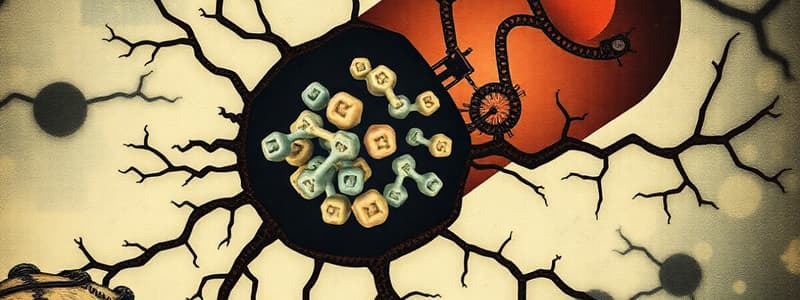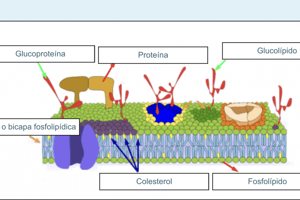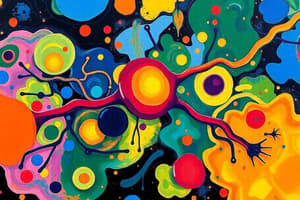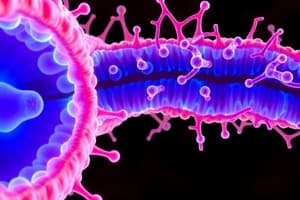Podcast
Questions and Answers
What is the primary function of the inner membrane of the mitochondria?
What is the primary function of the inner membrane of the mitochondria?
- Contains proteins that regulate molecule movement (correct)
- Facilitates gas exchange
- Stores excess ATP molecules
- Allows free movement of all molecules in and out
What role does the intermembrane space play in the mitochondria?
What role does the intermembrane space play in the mitochondria?
- Site of the Krebs cycle
- Rich in proton ions for the electron transport chain (correct)
- Houses mitochondrial DNA
- Area for fatty acid synthesis
Which process occurs in the mitochondrial matrix?
Which process occurs in the mitochondrial matrix?
- Fatty acid oxidation (correct)
- Protein transport
- Electron transport chain
- Oxidative phosphorylation
What is a byproduct of the electron transport chain?
What is a byproduct of the electron transport chain?
What is the primary molecule transported through the mitochondrial membranes during metabolic reactions?
What is the primary molecule transported through the mitochondrial membranes during metabolic reactions?
What is the role of ribosomes in the mitochondria?
What is the role of ribosomes in the mitochondria?
Which component is responsible for the synthesis of ATP during oxidative phosphorylation?
Which component is responsible for the synthesis of ATP during oxidative phosphorylation?
Which of the following proteins is NOT involved in mitochondrial protein transport?
Which of the following proteins is NOT involved in mitochondrial protein transport?
What is the primary function of converting pyruvate to Acetyl-CoA in mitochondria?
What is the primary function of converting pyruvate to Acetyl-CoA in mitochondria?
Which process takes place in the mitochondria and is involved in the breakdown of fatty acids?
Which process takes place in the mitochondria and is involved in the breakdown of fatty acids?
What is the main function of the electron transport chain in mitochondria?
What is the main function of the electron transport chain in mitochondria?
Which cycle in mitochondria is responsible for detoxifying ammonia?
Which cycle in mitochondria is responsible for detoxifying ammonia?
Under what condition do mitochondria convert Acetyl-CoA into ketone bodies?
Under what condition do mitochondria convert Acetyl-CoA into ketone bodies?
Which statement correctly describes the role of mitochondria in protein transport?
Which statement correctly describes the role of mitochondria in protein transport?
What is the significance of mitochondrial DNA replication?
What is the significance of mitochondrial DNA replication?
How are mitochondria connected to the endosymbiotic theory?
How are mitochondria connected to the endosymbiotic theory?
Which metabolic reaction converts acetyl-CoA into ketone bodies?
Which metabolic reaction converts acetyl-CoA into ketone bodies?
What is the main role of the 70S ribosomes found in mitochondria?
What is the main role of the 70S ribosomes found in mitochondria?
Which process involves the removal of ammonia to form urea?
Which process involves the removal of ammonia to form urea?
In which part of the cell does the Krebs Cycle occur?
In which part of the cell does the Krebs Cycle occur?
What is one function of the electron transport chain in mitochondria?
What is one function of the electron transport chain in mitochondria?
Which of the following processes occurs partly in the mitochondria for detoxification?
Which of the following processes occurs partly in the mitochondria for detoxification?
Which of the following correctly describes the relationship between mitochondria and the endosymbiotic theory?
Which of the following correctly describes the relationship between mitochondria and the endosymbiotic theory?
What is one of the roles of mitochondria in programmed cell death?
What is one of the roles of mitochondria in programmed cell death?
What is the primary role of the cristae in mitochondria?
What is the primary role of the cristae in mitochondria?
Which of the following accurately describes the outer membrane of the mitochondria?
Which of the following accurately describes the outer membrane of the mitochondria?
What generates ATP during oxidative phosphorylation?
What generates ATP during oxidative phosphorylation?
What is primarily found in the mitochondrial matrix?
What is primarily found in the mitochondrial matrix?
Which process occurs in the mitochondria and is essential for generating electron carriers?
Which process occurs in the mitochondria and is essential for generating electron carriers?
Which of the following statements is correct about mitochondrial transport?
Which of the following statements is correct about mitochondrial transport?
What is a significant consequence of the electron transport chain's activity?
What is a significant consequence of the electron transport chain's activity?
Which metabolic reaction primarily occurs in the mitochondrial matrix?
Which metabolic reaction primarily occurs in the mitochondrial matrix?
Flashcards are hidden until you start studying
Study Notes
Mitochondria Structure
- Sausage-shaped organelle within cells
- Outer membrane: Highly permeable, allows for easy transport of molecules into and out of mitochondria.
- Inner membrane: Less permeable, possesses selective proteins and transporters regulating molecule movement (e.g., protons).
- Intermembrane space: The space between the outer and inner membrane, rich in proton ions; plays a crucial role in the electron transport chain.
- Cristae: Invaginations of the inner membrane, increasing surface area for metabolic reactions.
- Mitochondrial matrix: The fluid-filled space inside the inner membrane, containing:
- Mitochondrial DNA (mtDNA): Maternal in origin, encodes for specific proteins and RNAs.
- Ribosomes: Needed for the translation of mtDNA-encoded RNA into proteins.
Mitochondria Membrane Functions
- Protein Transport: Accepts unfolded proteins from the nucleus through specialized translocases (Tom and Tim) and further folds and activates them within the matrix.
- Miscellaneous Transport: Facilitates transport of various molecules crucial for metabolic reactions such as:
- Carbohydrates (e.g., glucose)
- Fatty acids
- Amino acids
- Electron Transport chain: Located on the inner mitochondrial membrane, utilizes protein complexes and electron carriers (NADH and FADH2) to create energy for ATP production via oxidative phosphorylation.
- The electron transport chain pumps protons into the intermembrane space, creating a concentration gradient.
- Protons flow down the gradient through ATP synthase, generating energy to convert ADP and inorganic phosphate into ATP.
- A byproduct of the electron transport chain: reactive oxygen species (ROS).
Mitochondria Matrix Functions
- Metabolic Reactions:
- Krebs cycle: Takes place in the mitochondrial matrix and involves the breakdown of acetyl-CoA, generating energy carriers like NADH and FADH2.
- Gluconeogenesis: The process of synthesizing glucose.
- Fatty acid oxidation (beta-oxidation): Breaking down fatty acids for energy.
- Urea cycle: The process of removing ammonia from the body.
Mitochondrial DNA & Ribosomes
- Mitochondrial DNA (mtDNA): Responsible for encoding a small number of proteins (around 15) used for mitochondrial functions.
- Ribosomes: Enable the translation of mtDNA-encoded RNA into proteins.
Mitochondria Functions
- Pyruvate to Acetyl-CoA Conversion: Converts pyruvate, a product of glycolysis, into Acetyl-CoA, the fuel for the Krebs cycle.
- Krebs Cycle: Involved in the breakdown of carbohydrates, fats, and proteins, yielding energy carriers like NADH and FADH2.
- Beta Oxidation of Fatty Acids: Breaks down fatty acids into Acetyl-CoA for energy production.
- Urea Cycle: Detoxes ammonia, a toxic byproduct of amino acid metabolism, by converting it into urea for excretion.
- Gluconeogenesis: Synthesizes glucose from non-carbohydrate sources like amino acids and odd-chain fatty acids, crucial when glucose levels are low.
- Heme Synthesis: Produces heme, a component of hemoglobin, in both the mitochondrial matrix and cytoplasm.
- Ketogenesis: Under certain conditions, converts Acetyl-CoA into ketone bodies, an alternative energy source when blood sugar levels are low.
- Electron Transport Chain: Utilizes electron carriers (NADH and FADH2) to generate ATP through oxidative phosphorylation.
- Protein Transport: Imports proteins essential for mitochondrial function from the cytoplasm.
- Miscellaneous Transport: Regulates the movement of various molecules across the mitochondrial membranes.
- Apoptosis (Programmed Cell Death): Releases cytochrome c from the matrix, triggering a cascade of events leading to cell death.
- DNA Replication: Replicates mitochondrial DNA, enabling the division of mitochondria (fission) to create new mitochondria.
- Transcription and Translation: Mitochondrial DNA produces RNA through transcription and then translates this RNA into proteins using 70S ribosomes, essential for mitochondrial function.
Interesting Facts About Mitochondria
- The mitochondria is involved in a vast number of metabolic reactions.
- The urea cycle, gluconeogenesis, and heme synthesis occur both in the mitochondria and the cytoplasm.
- Mitochondria used to be free-living bacteria, as suggested by the endosymbiotic theory, which explains their DNA and 70S ribosomes.
- Mitochondria contain about 15% of the proteins needed for its function, while the remaining 85% are imported from the nucleus and cytoplasm.
Mitochondria Structure
- Sausage-shaped organelle found within cells
- Outer membrane: Highly permeable, allowing easy transport of molecules
- Inner membrane: Less permeable, containing selective proteins and transporters for regulated molecule movement
- Intermembrane space: Space between outer and inner membranes, rich in proton ions, playing a crucial role in the electron transport chain
- Cristae: Invaginations of the inner membrane, increasing surface area for metabolic reactions
- Mitochondrial matrix: Fluid-filled space inside the inner membrane, containing:
- Mitochondrial DNA (mtDNA): Maternal in origin, encodes specific proteins and RNAs
- Ribosomes: Needed for translation of mtDNA-encoded RNA into proteins
Mitochondria Membrane Functions
- Protein Transport: Accepts unfolded proteins from the nucleus through specialized translocases (Tom and Tim) and further folds and activates them within the matrix
- Miscellaneous Transport: Facilitates transport of various molecules crucial for metabolic reactions, such as:
- Carbohydrates (e.g., glucose)
- Fatty acids
- Amino acids
- Electron Transport Chain: Located on the inner mitochondrial membrane, utilizes protein complexes and electron carriers (NADH and FADH2) to create energy for ATP production via oxidative phosphorylation
- Pumps protons into the intermembrane space, creating a concentration gradient
- Protons flow down the gradient through ATP synthase, generating energy to convert ADP and inorganic phosphate into ATP
- Byproduct: reactive oxygen species (ROS)
Mitochondria Matrix Functions
- Metabolic Reactions:
- Krebs cycle: Takes place in the mitochondrial matrix, breaks down acetyl-CoA, generating energy carriers like NADH and FADH2
- Gluconeogenesis: Synthesizes glucose
- Fatty acid oxidation (beta-oxidation): Breaks down fatty acids for energy
- Urea cycle: Removes ammonia from the body
Mitochondrial DNA & Ribosomes
- Mitochondrial DNA (mtDNA): Encodes a small number of proteins (around 15) used for mitochondrial functions
- Ribosomes: Enable the translation of mtDNA-encoded RNA into proteins
Mitochondria Functions
- Pyruvate to Acetyl-CoA Conversion: Converts pyruvate, a glycolysis product, into Acetyl-CoA, the fuel for the Krebs cycle
- Krebs Cycle: Breaks down carbohydrates, fats, and proteins, yielding energy carriers like NADH and FADH2
- Beta Oxidation of Fatty Acids: Breaks down fatty acids into Acetyl-CoA for energy production
- Urea Cycle: Detoxes ammonia, converting it into urea for excretion
- Gluconeogenesis: Synthesizes glucose from non-carbohydrate sources, crucial when glucose levels are low
- Heme Synthesis: Produces heme, a component of hemoglobin, in both the mitochondrial matrix and cytoplasm
- Ketogenesis: Converts Acetyl-CoA into ketone bodies, an alternative energy source when blood sugar levels are low
- Electron Transport Chain: Utilizes electron carriers (NADH and FADH2) to generate ATP through oxidative phosphorylation
- Protein Transport: Imports proteins essential for mitochondrial function from the cytoplasm
- Miscellaneous Transport: Regulates the movement of various molecules across the mitochondrial membranes
- Apoptosis (Programmed Cell Death): Releases cytochrome c from the matrix, triggering a cascade of events leading to cell death
- DNA Replication: Replicates mitochondrial DNA, enabling mitochondrial division (fission) to create new mitochondria
- Transcription and Translation: Mitochondrial DNA produces RNA through transcription and then translates this RNA into proteins using 70S ribosomes, essential for mitochondrial function
Interesting Facts About Mitochondria
- Involved in a vast number of metabolic reactions
- The urea cycle, gluconeogenesis, and heme synthesis occur both in the mitochondria and the cytoplasm
- Mitochondria used to be free-living bacteria, as suggested by the endosymbiotic theory, which explains their DNA and 70S ribosomes
- Mitochondria contain about 15% of the proteins needed for its function, while the remaining 85% are imported from the nucleus and cytoplasm
Mitochondria Structure
- Mitochondria are sausage-shaped organelles found within cells.
- They have a double membrane:
- The outer membrane is highly permeable.
- The inner membrane is less permeable and regulated by proteins and transporters.
- The space between the membranes is called the intermembrane space and is highly concentrated with proton ions.
- The inner membrane folds into cristae, which increase surface area for metabolic reactions.
- The mitochondrial matrix is the innermost region filled with fluid and solutes including:
- Mitochondrial DNA (maternal DNA)
- Ribosomes for translation of mitochondrial RNA into proteins.
Mitochondrial Membrane Functions
- Mitochondria import proteins from the nucleus to be folded and activated in the matrix.
- Tom (outer membrane translocase) transports proteins to the intermembrane space.
- Tim (inner membrane translocase) transports proteins to the mitochondrial matrix.
- The inner membrane is less permeable than the outer membrane, regulating the movement of small molecules and ions for metabolic reactions.
- The electron transport chain is located on the inner membrane.
- It utilizes protein complexes (complex I-IV) and ATP synthase.
- High-energy electrons from NADH and FADH2 are passed along the chain, releasing energy to pump protons into the intermembrane space.
- Oxidative phosphorylation generates ATP through the movement of protons down their concentration gradient through ATP synthase.
- Reactive oxygen species (ROS) can be a byproduct of the electron transport chain and can damage molecules.
Mitochondrial Matrix Functions
- Many metabolic reactions occur within the mitochondrial matrix.
- Pyruvate is converted to acetyl-CoA.
- The Krebs cycle (citric acid cycle) produces ATP and electron carriers NADH and FADH2.
- Other metabolic reactions taking place here:
- Gluconeogenesis (glucose synthesis from non-carbohydrate sources)
- Fatty acid oxidation (beta-oxidation)
- Urea cycle (ammonia removal)
Mitochondrial DNA and Ribosomes
- Mitochondria have their own 70S ribosomes, similar to those found in prokaryotes.
- Mitochondrial DNA can replicate itself, essential for mitochondrial fission.
- Mitochondrial DNA undergoes transcription to produce RNA, which is then translated by the 70S ribosomes.
- These proteins are essential for mitochondrial function.
- The endosymbiotic theory suggests that mitochondria were once independent prokaryotic cells engulfed by eukaryotic cells explaining the presence of their own DNA and ribosomes.
Other Mitochondrial Functions
- Mitochondria have specialized transport mechanisms for proteins across their membranes.
- The electron transport chain on the inner membrane produces ATP.
- Mitochondria play a role in programmed cell death (apoptosis) through the release of cytochrome C.
Studying That Suits You
Use AI to generate personalized quizzes and flashcards to suit your learning preferences.




